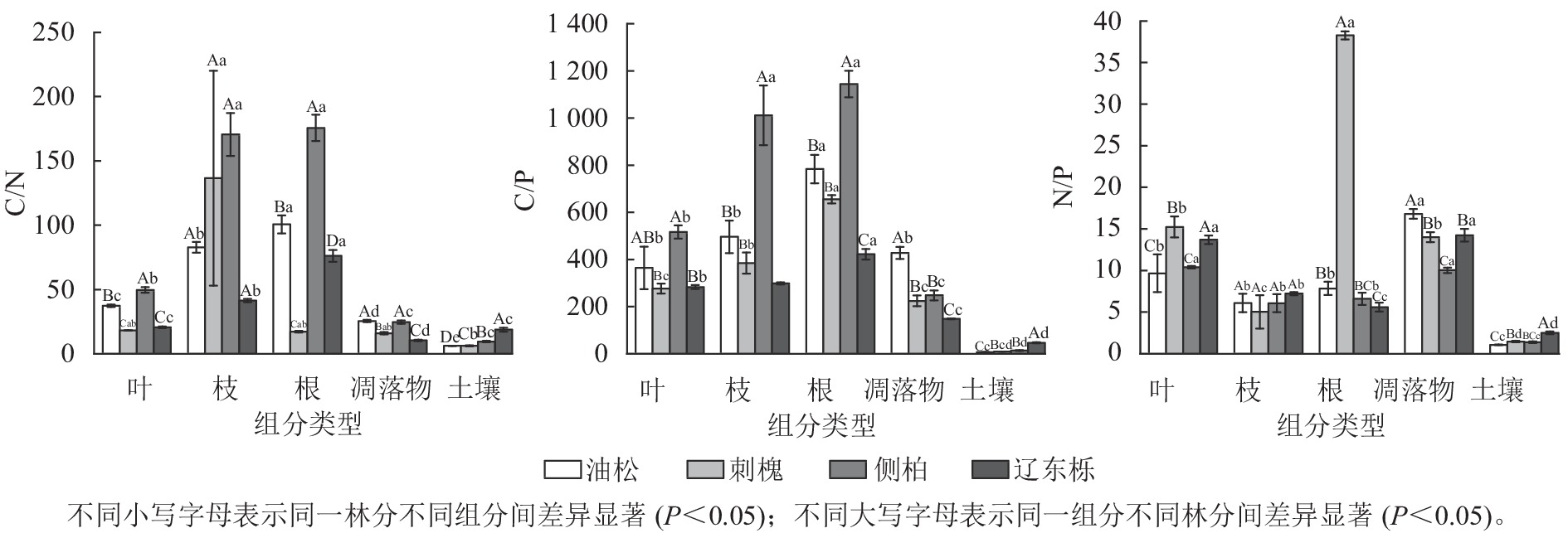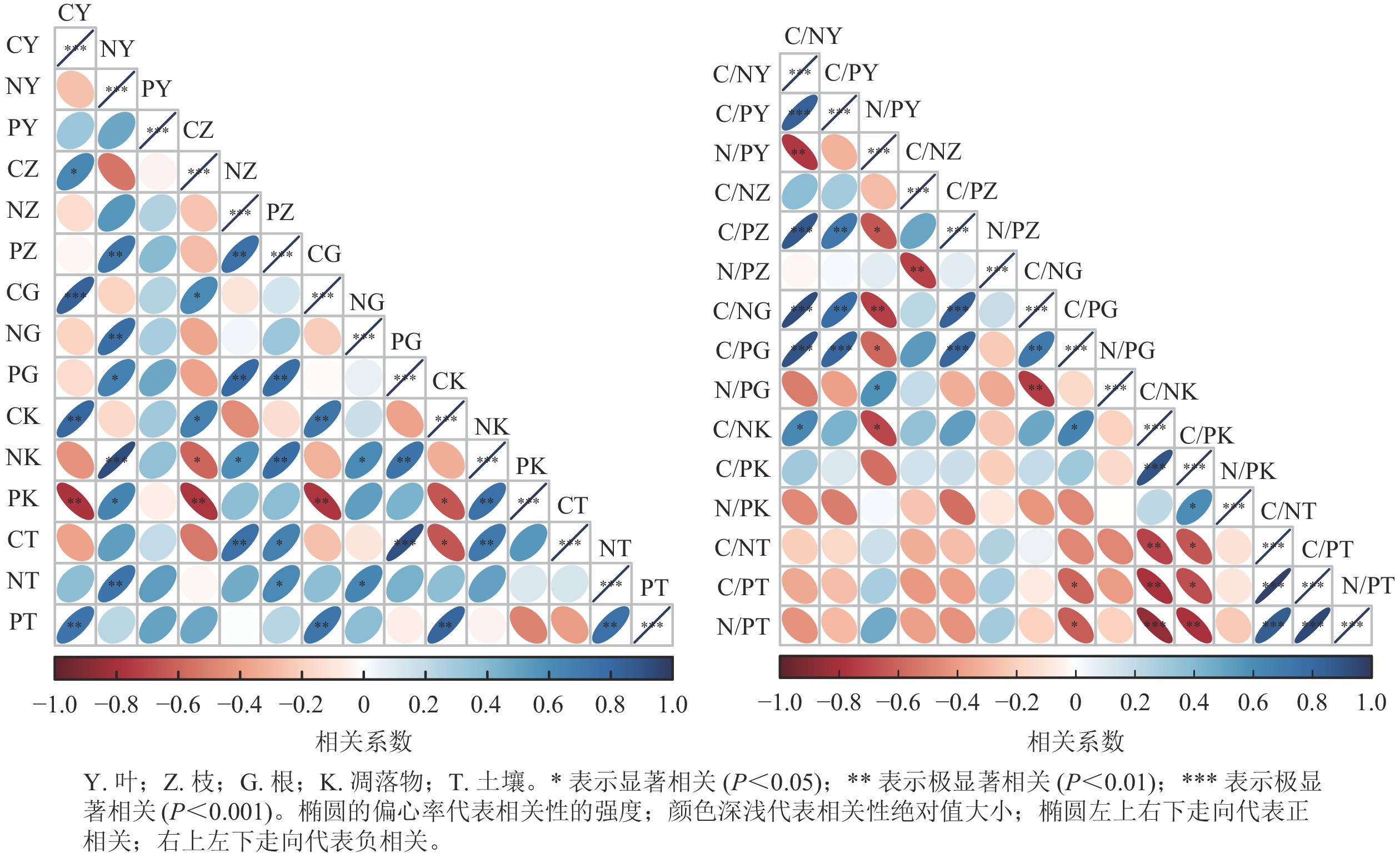-
生态化学计量学主要关注生物地球化学循环过程中营养元素间的相互作用与平衡[1],从植物生态学、土壤学等多学科角度探究植物器官、物种、群落和生态系统的元素计量关系和规律,广泛用于判断植物体和群落的养分限制状况[2]、指导生态系统养分管理[3]、预测全球养分变化背景下的植被动态研究[4]。植物-凋落物-土壤是陆地生态系统重要的养分储存库,三者之间彼此影响和制约。植物养分输移活动通过叶片从大气中固定碳(C),依靠枝在植物各器官间进行养分运转,借助根系吸收和存储土壤中的养分,最后以凋落物淋溶、光降解、微生物分解和根系分泌等方式将C、氮(N)、磷(P)等元素归还土壤[5],因此,以上循环形成了植物-凋落物-土壤的C、N、P生态系统组分连续体,其关联性有助于深入认识植被各组分对营养元素的利用与分配规律。目前,研究多集中在区域土壤与植物单一器官(叶片)的生态化学计量比研究,如梁楚欣等[6]探究了滇东石漠化区不同植被恢复模式下土壤C、N、P质量分数及化学计量比的差异,王浩伊等[7]研究了大兴安岭不同生活型针叶生态化学计量与生长阶段的关系,而对于植物多器官(叶、枝、根)-凋落物-土壤为整体的相关研究较少。因此,阐明植物-凋落物-土壤生态系统养分循环及调控机制,可揭示生态系统植物-凋落物-土壤之间的物质循环特征。黄土高原生态环境敏感,独特的地貌导致水土流失严重[8]。植被恢复能有效防治水土流失,随着人工恢复为主的“退耕还林还草”工程的实施[9],黄土高原植被覆盖率、土壤质量明显提升,形成了自然恢复和人工恢复为主的植被类型[10]。以往对黄土高原植被恢复的生态化学计量研究,集中在单一树种不同器官[11]、不同密度人工林土壤[12]等方面,关于不同植被恢复类型下植物各器官生态化学计量特征、凋落物与土壤生态化学计量特征关系的研究仍较少。鉴于此,为系统了解植被恢复过程中植物与土壤的生态过程,本研究以黄土丘陵区人工恢复植被油松Pinus tabuliformis林、刺槐Robinia pseudoacacia林、侧柏Platycladus orientalis林为研究对象,以自然恢复植被辽东栎Quercus liaotungensis天然次生林为对照,系统研究乔木叶、枝、根,凋落物和土壤生态化学计量特征,揭示黄土高原生态系统的生态过程、养分循环和限制因素,为黄土高原人工林植被恢复工作和森林经营改造提供科技支撑。
-
研究区位于山西省吉县森林生态系统国家野外科学观测研究站所在地的蔡家川流域(35°53′~36°21′N,110°27′~110°07′E),该区地处黄土高原东南部半湿润地区,属于典型的黄土残塬沟壑区,季风气候显著,年平均气温为10 ℃,年平均降水量为579 mm,年平均蒸发量达1 729 mm,降水集中在6—9月,海拔为400~1 820 m。本研究选取蔡家川流域具有典型代表性的人工油松林、刺槐林、侧柏林、辽东栎天然次生林,林下植物主要为丁香Syringa oblata、黄刺玫Rosa xanthina、绣线菊Spiraea salicifolia、青蒿Artemisia caruifolia、连翘Forsythia suspensa、梾木Cornus macrophylla、糙苏Phlomoides umbrosa、紫菀Aster tataricus等。自1991年起,在蔡家川流域内进行退耕还林的全面植被恢复工作,流域内梁峁坡沟综合规划设计,营造人工林,保护天然林,栽植了油松、刺槐及侧柏等适应性强、耐干旱瘠薄的树种,该人工林为生态公益林,没有进行间伐、施肥等人工经营措施,天然林采取自然恢复的方式。研究区样地基本特征见表1。
林分 海拔/m 坡度/(°) 坡向 平均树高/m 平均胸径/cm 凋落物厚度/cm 郁闭度/% 林分密度/(株·hm−2) 油松林 1 147 20 北向 10.5 14.0 2.4 50 1 680 刺槐林 1 123 7 东向 10.5 12.9 2.9 71 1 310 侧柏林 1 186 14 西北向 7.5 8.4 1.0 49 1 200 辽东栎林 1 141 25 东南向 9.3 11.2 3.1 67 1 150 Table 1. Basic information about the sampling site in the study area
-
于2022年7—8月进行外业调查。在每个长势良好的人工油松林、刺槐林、侧柏林和天然次生林辽东栎林等典型样地,分设3个乔木样方(20 m×20 m),在样方内进行每木检尺,调查郁闭度、树高和胸径等指标。样方内挑选3株长势均匀的标准木,在树冠处同一层东、西、南、北4个方位采集健康成熟的叶片与细枝(直径<2 cm),在标准木的冠幅范围内随机钻取3个0~60 cm的土芯,用冲洗法获取根样品(直径<2 mm),分别混匀后装入塑封袋;在样方内按对角线法选取3个1 m×1 m的具有代表性的凋落物样方,采集枯枝落叶(未分解、半分解和已分解),混匀后装入塑封袋;五点取样法采集0~20 cm土层土壤样品,混匀后装入塑封袋。以上采集的样品带回实验室后,叶、枝、根在100 ℃杀青15 min,随后降温至65 ℃恒温,将叶、枝、根与凋落物烘干至恒量,粉碎,过0.15 mm筛。土壤样品自然风干后,研磨过0.25 mm筛。采用元素分析仪测定全碳、全氮,采用硫酸-高氯酸消煮-钼锑抗比色法测定全磷。
-
采用SPSS 25.0对数据进行K-S检验,验证数据正态性;采用单因素方差分析(one-way ANOVA)比较不同林分类型及不同组分生态化学计量差异;经方差齐性检验,使用最小显著性差异法(LSD)进行显著性检验(α=0.05);采用R 4.3.1对其进行相关性分析;绘图均在Origin 2021和R 4.3.1中进行。
-
由图1可知:4个林分的植物叶、枝、根平均C质量分数分别为516.35、495.05、490.76 g·kg−1,平均N质量分数为19.14、6.75、10.46 g·kg−1,平均P质量分数为1.61、1.11、0.74 g·kg−1。各林分器官间叶的N、P质量分数显著高于枝和根(P<0.05)。
不同林分植物各器官-凋落物-土壤C、N、P质量分数存在显著差异(P<0.05)。油松叶、枝、根和凋落物C质量分数最高;辽东栎土壤C质量分数最高;刺槐叶、根和土壤N质量分数最高;辽东栎枝和凋落物N质量分数最高;侧柏各组分中的N质量分数均显著低于其他树种(P<0.05);油松叶和土壤P质量分数最高,侧柏叶、枝、根P质量分数最低。
-
由图2可知:4个林分的植物叶、枝、根平均C/N分别为31.44、107.79、92.40,平均C/P为360.02、547.72、751.41,平均N/P为12.25、6.11、14.58。根的C/N和C/P显著高于叶和枝(P<0.05)。

Figure 2. C, N and P stoichiometric ratios of plant organs, litter and soil of different forest stands
不同林分植物各器官-凋落物-土壤C/N、C/P、N/P存在显著差异(P<0.05)。侧柏叶、枝、根的C/N和C/P显著高于其他树种(P<0.05),枝、根、凋落物的C/P在不同林分中表现为辽东栎最低。油松凋落物的C/N、C/P、N/P显著高于其他树种(P<0.05)。辽东栎土壤的C/N、C/P、N/P显著高于其他树种(P<0.05),油松土壤的C/N、C/P、N/P显著低于其他树种(P<0.05)。
-
如图3所示:典型林分植物叶、枝、根的C、N呈显著正相关(P<0.05)。叶C与凋落物C、土壤P呈极显著正相关(P<0.01),与凋落物P呈极显著负相关(P<0.01);叶N与凋落物N、P、土壤N呈显著正相关(P<0.05);枝C与凋落物C呈显著正相关(P<0.05),与凋落物N、P呈显著负相关(P<0.05);枝N与凋落物N、土壤C呈显著正相关(P<0.05);枝P与凋落物N、土壤C、N呈显著正相关(P<0.05);根C与凋落物C、土壤P呈显著正相关(P<0.05),与凋落物P呈显著负相关(P<0.05);根N与凋落物N、土壤N呈显著正相关(P<0.05),凋落物C与凋落物P、土壤N呈显著负相关(P<0.05),与土壤P呈极显著正相关(P<0.01);土壤N与土壤P呈极显著正相关(P<0.01)。

Figure 3. Correlations between plant organs, litter and soil stoichiometric characteristics of typical forest stands
叶C/N与凋落物C/N呈极显著正相关(P<0.001);叶N/P与凋落物C/N呈显著负相关(P<0.05);根C/P与凋落物C/N呈显著正相关(P<0.05),与土壤C/P、N/P呈显著负相关(P<0.05);凋落物C/N、C/P均与土壤C/N、C/P呈极显著负相关(P<0.01),与N/P呈极显著相关(P<0.001);土壤C/N与土壤C/P、N/P呈极显著正相关(P<0.001);土壤C/P与土壤N/P呈极显著正相关(P<0.001)。
-
植物C、N、P养分分配及环境因子共同决定了植物的生长发育和营养水平[13]。本研究中4种林分乔木叶片C、N、P平均为516.35、18.64、1.61 g·kg−1,叶片C质量分数较全球植物叶片平均值(461.6 g·kg−1)偏高,但是N、P质量分数低于全球平均水平(20.6、2.0 g·kg−1)[1]。说明该研究区的C储备丰富,N、P较为贫瘠。这与黄土高原土壤结构松散,水土流失严重,植物难以从土壤中吸收N、P元素有关[14],亦与中国土壤P质量分数普遍较低的规律一致[15]。本研究中,油松叶片、枝、根C质量分数高于其他植被,表明油松体内积累了更多的有机质,能更好地抵御不良环境的侵扰,这与马钦彦等[16]对针叶树种的研究结果一致。相关研究表明:植物C质量分数越高,植物对外界不利条件的抵抗能力越强[17]。油松作为常绿针叶树种,叶片角质层发达,含有大量木质素与单宁等含碳化合物,具有更强的叶片韧性,可以更好地承受外界物理损伤。刺槐各组分间N质量分数显著高于其他植被类型,刺槐作为豆科Leguminosae植物,通过根瘤固定空气中的N,具有较强的固氮能力[18],可以缓解黄土高原普遍缺N的现象。
植物叶C/N、C/P与植物的固氮能力、养分吸收和利用效率存在正反馈机制,与植物生长速率存在负反馈机制[19]。本研究中,刺槐叶C/N、C/P最低,表明刺槐在生长过程中生长速率较快。相关研究表明:植物叶N/P能够解释植物养分的受限制情况[20]。本研究中,油松、侧柏和辽东栎叶的平均N/P为8.34~13.71。胡耀升等[21]研究表明:当N/P<14时,植物的生长受N的限制;当14<N/P<16时,植物的生长同时受N、P共同限制。而本研究结果表明:黄土丘陵区油松、侧柏、辽东栎的生长主要受N限制,刺槐N/P为15.24,说明刺槐的生长同时受N和P的限制。凋落物是植物与土壤养分循环之间的纽带[22],其分解速率的快慢和养分释放的多少决定了植物的养分利用效率和土壤养分的供应状况[23]。其中,凋落物的C/N、C/P能反映其分解速率,C/N、C/P较低时凋落物更易分解。本研究中,油松凋落物C/N、C/P高于其他树种,不易分解,这是因为油松凋落物中较高的C和较低的C/N抑制了微生物的分解作用[24]。有研究发现:凋落物N/P也可以表征其分解速率的受限制情况[25]。本研究中,黄土丘陵区4种林分凋落物N/P均低于25,表明研究区凋落物分解主要受N限制。研究区土壤C/N、C/P平均值远小于全国平均值[26],这与郭鑫等[27]的研究结果一致,表明研究区土壤有机质分解矿化作用较快,不利于土壤有机质积累,且土壤P的有效性较高,土壤微生物受P的限制作用较小。作为衡量土壤质量的重要参数,土壤N/P可以表征土壤养分限制情况,本研究中黄土丘陵区土壤N/P远低于中国陆地平均水平[26],表明研究区内植物生长主要受限于土壤N。
在长期的进化过程中,植物通过调节养分配置,形成相应的元素分配规律,从而产生对应的生长特性,以适应外界环境的变化。本研究中不同器官C、N、P质量分数及其计量比存在密切联系,叶与根的C、N质量呈显著正相关,说明叶与根养分分配具有协同性,这与王淳等[28]的研究结果一致。不同器官间的C/N、C/P、N/P均呈显著正相关,说明不同器官之间相互促进,协同增长;植物资源利用在不同植物器官间是一致的,同时也受相同元素限制。因此,分析植物、凋落物和土壤间C、N、P及化学计量特征的相关关系,有助于解释生态系统养分循环的内部调控规律[29]。
本研究中典型林分植物各器官C、N与凋落物C、N呈显著正相关,叶C/N与凋落物C/N呈显著正相关,可见,植物与凋落物在各元素间存在较强的相关性,这是因为叶片是凋落物的直接来源,两者之间存在养分转移。叶和根的N与土壤N呈显著正相关关系,表明叶和根与土壤供给的氮之间相互促进。凋落物C与土壤C呈显著负相关,凋落物C/N、C/P与土壤C/N、C/P、N/P间呈显著负相关,说明凋落物是植物地上部分与土壤之间的介质,凋落物分解速率的快慢,影响着凋落物与土壤之间的养分循环关系[30]。凋落物分解速率慢,其自身养分含量高,返还到土壤中的养分将减少,因此,凋落物与土壤元素之间存在负相关关系。
-
山西西南部黄土丘陵区典型林分乔木叶、枝、根、凋落物和土壤的生态化学计量特征具有显著差异,油松林具有较好的固碳能力,刺槐林具有较好的固氮效果。刺槐生长受N、P限制;油松、侧柏、辽东栎生长受N限制;研究区土壤氮缺乏且凋落物分解受N限制。典型林分植物叶、枝、根之间化学计量特征显著正相关,说明植物各器官养分分配具有协同性,凋落物与土壤之间化学计量特征显著负相关,表明凋落物和土壤之间的养分动态变化具有协变性。因此,从养分限制角度考虑,建议在晋西北黄土丘陵区人工林管护过程中合理营造刺槐混交林,增强固氮能力,并缓解N元素的养分限制性。
Ecological stoichiometric characteristics of typical forest stands in the Loess Hilly Region of southwest Shanxi
doi: 10.11833/j.issn.2095-0756.20230573
- Received Date: 2023-11-24
- Accepted Date: 2024-03-22
- Rev Recd Date: 2024-03-18
- Available Online: 2024-04-22
-
Key words:
- ecological stoichiometry /
- plantation /
- nutrient cycling /
- nutrient limitation
Abstract:
| Citation: | XIN Pengcheng, WEI Tianxing, CHEN Yuxuan, YU Huan, SHA Guoliang, GUO Xin, REN Kang. Ecological stoichiometric characteristics of typical forest stands in the Loess Hilly Region of southwest Shanxi[J]. Journal of Zhejiang A&F University. doi: 10.11833/j.issn.2095-0756.20230573 |

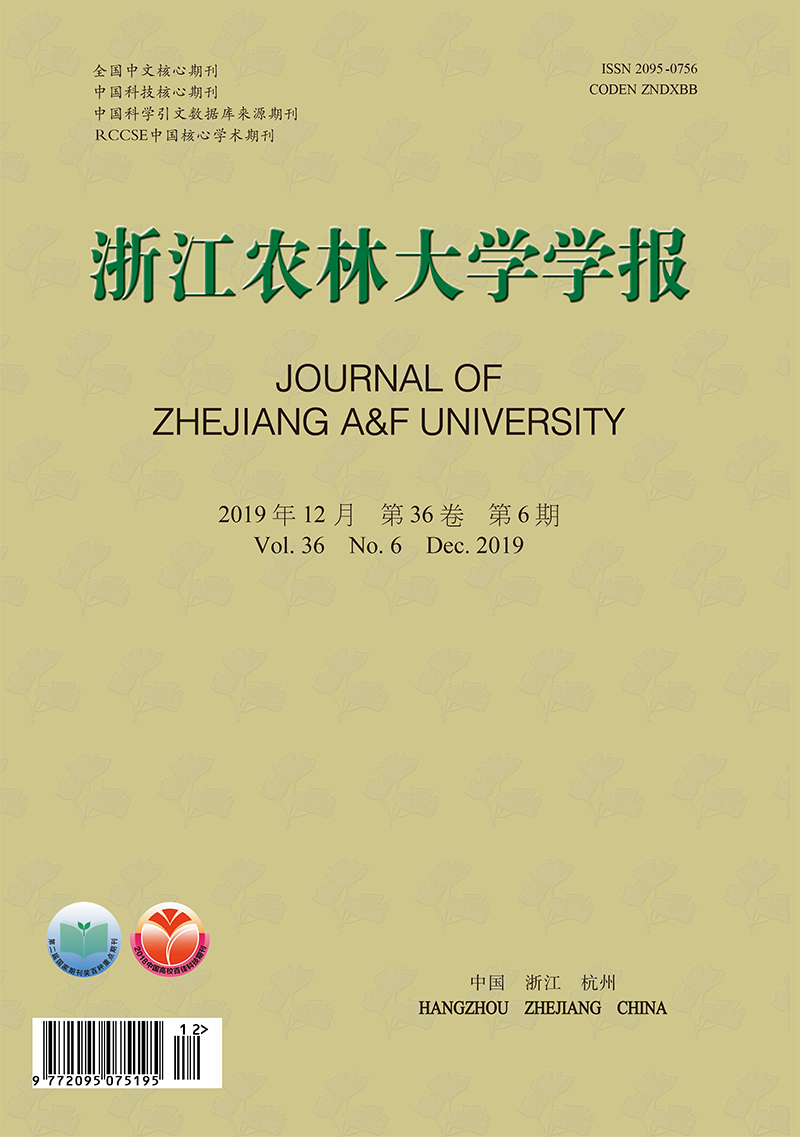


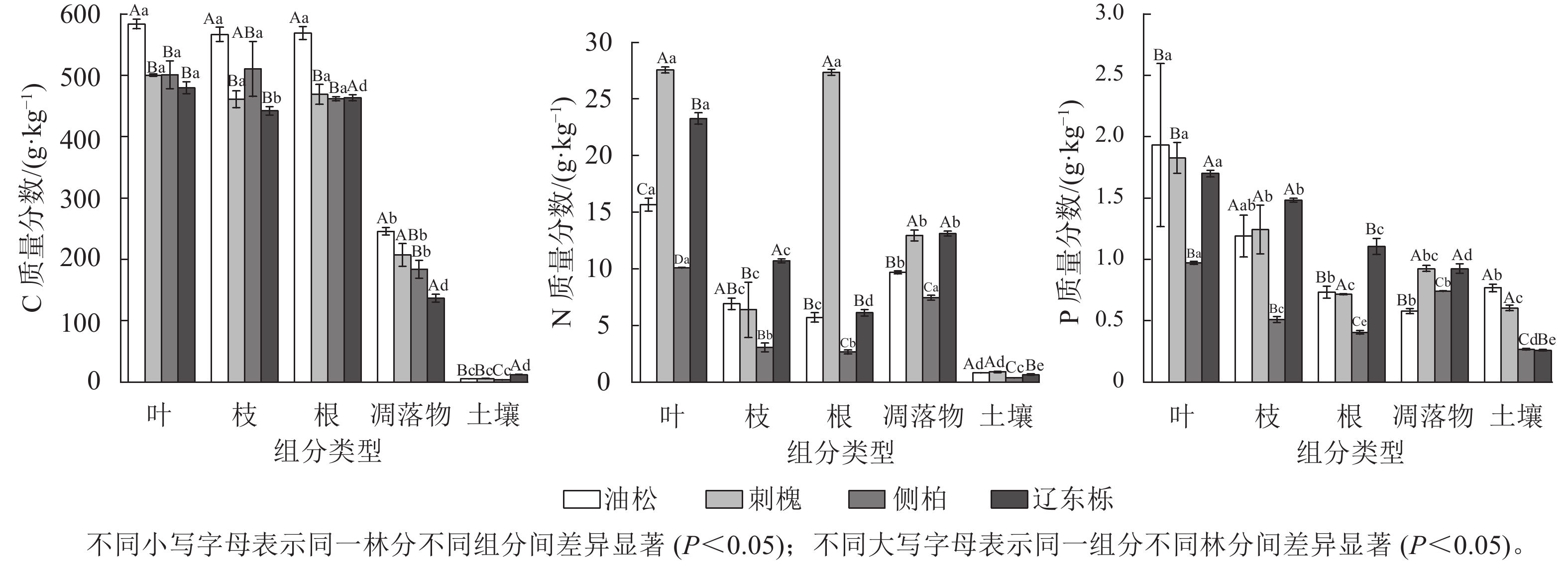


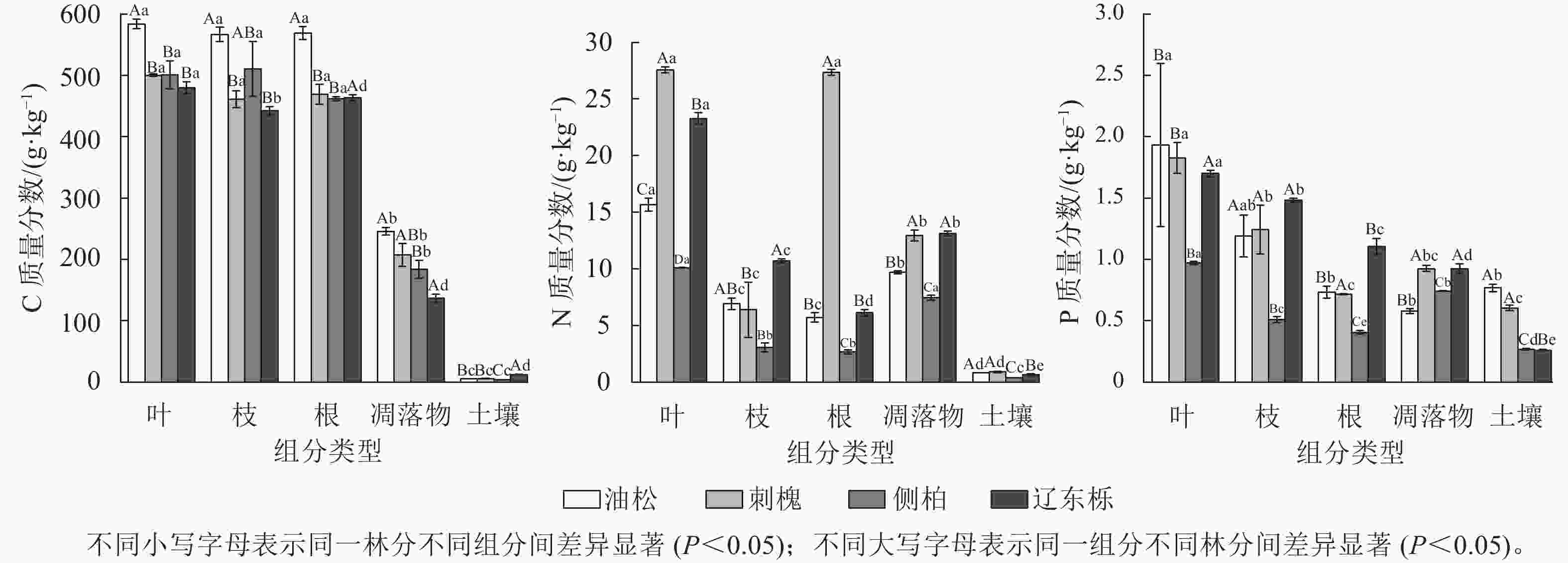
 DownLoad:
DownLoad:
